PPlanning a ski trip to the breathtaking Swiss Alps? Finding the best time to ski in Switzerland can make all the difference between an average vacation and an unforgettable alpine adventure. Switzerland, with its pristine slopes, world-class resorts, and picturesque mountain villages, offers some of the finest skiing experiences in the world. However, timing is everything when it comes to enjoying optimal snow conditions, manageable crowds, and reasonable prices in this winter wonderland.
Switzerland’s hallucinatory landscapes demand immediate action – grab boots, leap on board, toot bike bell and let spirits rip.
Nicola Williams
Switzerland’s ski season is a glorious mix of powder-perfect peaks, storybook villages, and seriously world-class resorts — but knowing when to go makes all the difference.

Image: Panoramic view of snow-covered Swiss Alps with skiers
In This Guide, You’ll Learn:
- The best months for snow quality, sunshine, and smaller crowds
- Budget-friendly periods (yes, they exist — even in Switzerland!)
- Resort-by-resort tips for 2025, from Zermatt to Verbier
- Local insights to help you ski smarter, not harder
- When to book, what to pack, and how to stay connected on the slopes
Understanding the Swiss Ski Season: When Winter Magic Happens
The Swiss ski season typically runs from late November to late April, though this can vary significantly depending on the resort, altitude, and yearly weather patterns. Let’s break down what you can expect throughout the winter months.
Early Season Skiing (Late November – December)
AKA: Where the snow whispers in before the crowds come crashing in
✅ Late November
- High-altitude heroes like Zermatt and Saas-Fee are usually first to open, thanks to their glacier runs
- Snow is limited elsewhere, but above 2,000m? You’re good to go
✅ Early to Mid-December
- Sweet spot alert: Decent snow + few tourists = more piste for you
- Great time for budget-friendly hotel deals and empty gondolas
🎄 Pre-Christmas
- Think: ski by day, mulled wine by twinkling lights at night
- Still relaxed — before the holiday madness begins
🎆 Christmas & New Year’s Week
- Atmosphere: magical
- Prices: astronomical
- Crowds: everywhere
Pro tip? Book waaaay ahead, or aim for the week before Christmas for all the vibes without the chaos

Image: Swiss Alps winter season ski
📶 Gohub eSIM tip: Use it to check real-time lift openings and snow reports — early season can be unpredictable!
Peak Season Skiing (January – February)
When the Alps are at their most dramatic — and the snow gods are generous
January
- Post-holiday calm + powder galore
- Cold temps = excellent snow retention, even in mid-altitude resorts
- Off-piste? Best time to go.
🔥 Pro tip: Mid-January is one of the least crowded weeks of peak season — perfect for solo riders or anyone who likes empty lifts and fresh tracks
February
- Still stellar snow — but brace yourself: it’s school holiday season across Europe
- Family crowds = packed lifts, higher prices — especially in popular resorts like Verbier & St. Moritz
- Avoid weekends if possible, or opt for lesser-known gems like Andermatt or Arosa
🧠 Reminder: February is when snow conditions hit their stride — great for skiers of all levels, especially if you’re aiming for long, all-day runs
📶 Gohub eSIM saves the day again: Use it to avoid peak lift times, book mountain lunches ahead, or slide into a last-minute fondue spot with 4.9 stars and a mountain view

Image: Skiers enjoying fresh powder in January with empty slopes
Spring Skiing in Switzerland (March–April): Sunshine, Snow & Après-Ski Bliss
Don’t let the word “spring” fool you. March and April still deliver excellent skiing, especially at higher elevations — just with more light, more chill, and more fun.
March: Peak Vibes + Great Conditions
- Snowpack is solid, especially in resorts like Zermatt, Verbier, and St. Moritz
- The days get noticeably longer, giving you more daylight for epic runs + extra après
- Late March hits the sweet spot:
- Good coverage
- Warmer temps
- Fewer crowds than February
April: Sunshine Turns & Sundecks Calling
- Glacier resorts (like Saas-Fee or Zermatt) still offer great spring skiing
- Lower resorts might get slushy by afternoon — so ski early, chill later
- Après-ski on a sunny terrace? Absolute chef’s kiss
- Easter holidays bring a little bump in visitors — especially families
🧳 Spring ski packing tip:
- Add sunglasses, lighter layers & SPF 50
- Still bring gloves — mornings can be chilly, and you’ll want comfy hands when snapping selfies with Matterhorn in the background
🧠 Pro tip: Start your day early while the snow is crisp, and spend the afternoon lounging with mountain views and a well-earned drink 😎

Image: Spring skiing in Switzerland
📶 Gohub eSIM on the Spring Slopes
- Book last-minute spring ski passes, or snag glacier ski lessons if snow is low
- Check lift openings & snow conditions (spring weather shifts fast!)
- Use Google Maps to find the best après-ski spots with live music or fondue terraces
Top Swiss Ski Resorts and Their Optimal Timing
Not all Swiss ski resorts are built the same — and that’s the magic of it. Whether you’re here for glacier power, deep powder days, or glamorous après with champagne in hand, each mountain has its moment.
Let’s match you with the perfect resort — at the perfect time.
Zermatt: Year-Round Glacier Skiing
Zermatt stands out as Switzerland’s premier ski destination with the highest ski terrain in Europe:
- Best Time: December to April
- Pro Power: Glacier skiing year-round
- Why Go: Ski under the shadow of the legendary Matterhorn, baby!
- Altitude bonus: Reaches up to 3,899m — that’s peak snow security, even when others get slushy
Perfect for: All-level skiers, snow lovers, and those who want to ski even in May
📶 Gohub eSIM in Zermatt: Use it to check live glacier cam, lift status, or book a spontaneous ski lesson at Klein Matterhorn mid-run
Verbier: Powder Paradise for Advanced Skiers
Vernier, which is part of the huge 4 Vallées ski area, is famous for its difficult slopes and lively atmosphere.
- Best Time: January – early March
- Off-Piste Dream: Mid-Jan to Feb = powder paradise
- Why Go: Part of the massive 4 Vallées, with legendary freeride zones
- Avoid: February holiday crowds (unless you like dodging humans on slopes)
Perfect for: Advanced skiers, adrenaline junkies, and party-après seekers
📲 Book last-minute heli-ski or backcountry guides directly from the slopes using your eSIM — yes, it’s that easy.
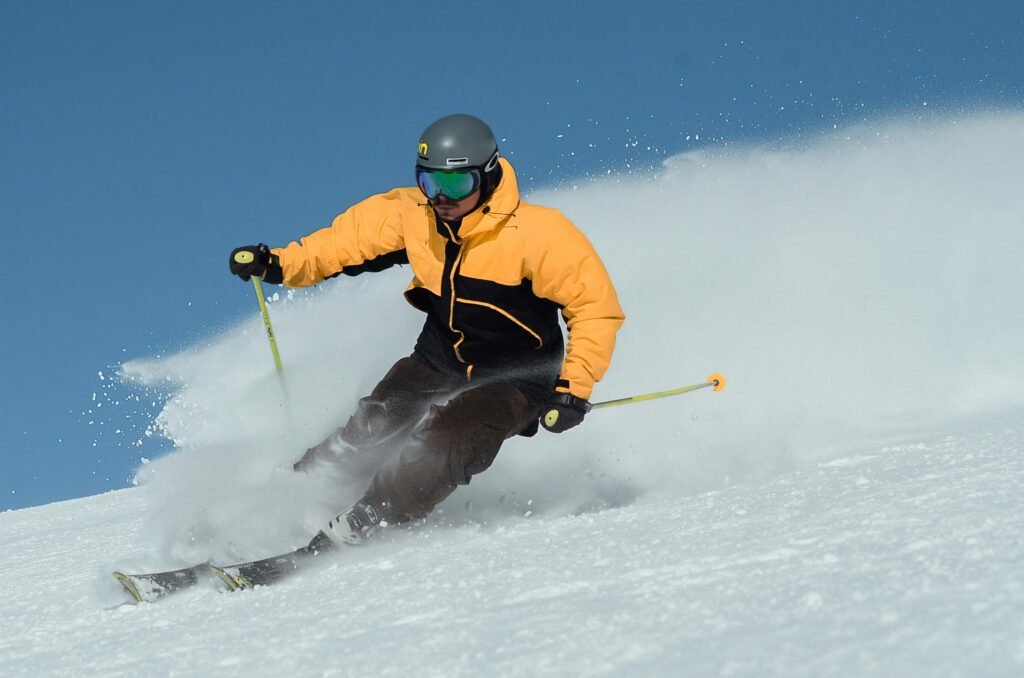
Image: Off-piste skiing in Verbier with fresh powder
St. Moritz: Sunny Slopes and Glamour
St. Moritz combines excellent skiing with luxury and glamour:
- Best Time: Late January – February
- Snow Meets Sun: 322 days of sunshine ☀️ + serious snow reliability
- Vibe: Think James Bond goes skiing meets Alpine art gallery
- Don’t Miss: Snow Polo World Cup in January = horses. On snow. Wild.
Perfect for: Style-savvy skiers, sun-chasers, and anyone who packs faux fur
📶 Gohub it: Get real-time weather + glam lunch spot recs while cruising through the Engadin sunshine
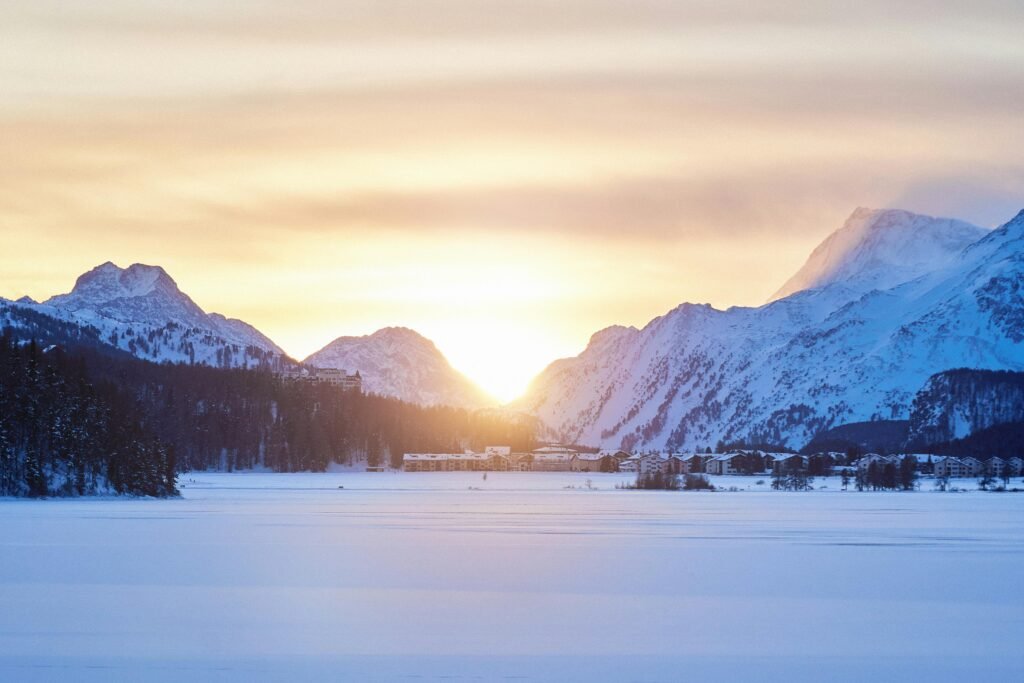
Image: Engadin Valley
Davos-Klosters: Extensive Terrain for All Levels
This extensive ski area offers something for everyone:
- Best Time: Mid-Jan to late Feb
- Crowd Note: Avoid WEF week in late Jan — unless you like skiing near world leaders 😅
- Why Go: Multiple mountains, zero boredom, great for all levels
- Family tip: February school holidays = excellent snow + energy (but book early)
- Spring sleeper hit: March brings sun + space
Perfect for: Families, groups, mixed-skill parties
📲 Use your Gohub eSIM to check the best beginner-friendly lifts, and hop between villages without missing a connection
Engelberg-Titlis: Powder Heaven Close to Zurich
Engelberg offers some of Switzerland’s best freeride terrain with easy access from Zurich:
- Best time: January through March for deepest snow
- Powder reputation: Often receives more snow than other Swiss resorts
- Laub run: This famous off-piste descent is best experienced from January to March
- Glacier advantage: The Titlis glacier extends the season into spring
Perfect for: Intermediate to expert skiers who want big-mountain vibes without the big ego crowd
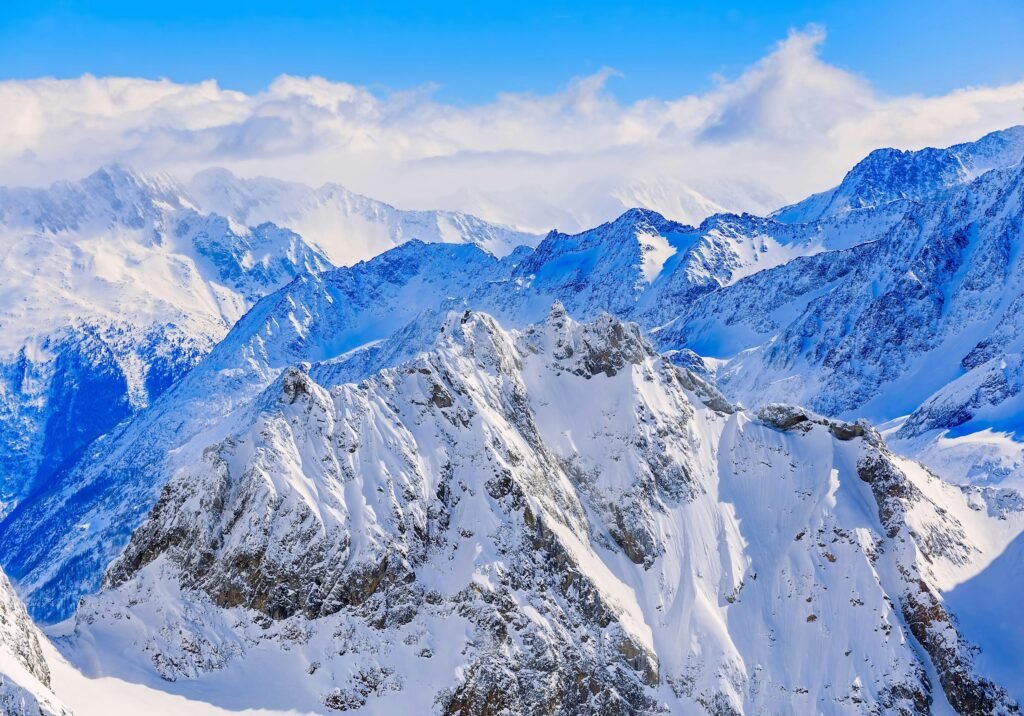
Image: Engelberg-Titlis
Engelberg’s north-facing slopes help preserve snow quality throughout the season, making it a reliable choice even when other resorts are struggling.
Gohub eSIM in Engelberg:
- Check avalanche bulletins before heading off-piste
- Book last-minute freeride guides or gear rentals
- Navigate back to après when the fog rolls in (Titlis can get moody!)
Snow Conditions and Weather Patterns in Swiss Ski Resorts
Timing your ski trip? Great.
Understanding where snow actually falls in Switzerland? Even better.
Because let’s face it — the Alps are big, moody, and weather doesn’t always read the forecast.
Here’s the lowdown on how snow and sunshine really behave across Swiss ski country:
Snowfall Patterns: Where the Powder Falls
Snow distribution in Switzerland isn’t uniform:
| Region | Snow Personality |
|---|---|
| 🇨🇭 Northern Alps (Engelberg, Andermatt) | Snow magnets! Frequent dumps from northwesterly storms make these the go-to for powder chasers |
| 🇨🇭 Southern Alps (Zermatt, Saas-Fee) | Catch snow from southerly systems crossing from Italy. When it hits — it dumps hard |
| 🇨🇭 Eastern Alps (St. Moritz, Davos) | Colder, drier, but snow lasts long thanks to frigid temps. Think blue skies + well-preserved pistes |
| 🇨🇭 Western Alps (Verbier, Portes du Soleil) | Benefit from Atlantic-fed storms, especially in Dec–Feb — unpredictable but often epic |
Deepest snow? Mid-Jan to late Feb
Wildcard win? Early December storms (hello powder bonus!)
Microclimate Considerations for Ski Holidays
Switzerland’s terrain is wildly dramatic — and that means weather shifts fast between valleys.
Sunny Microclimates:
- St. Moritz (Engadin Valley): Over 320 days of sunshine a year 😎
- Valais Region (Zermatt, Verbier): High altitude + clear skies = perfect combo
Snow Traps:
- Engelberg & Andermatt: Regularly top snow depth charts — but also see more clouds
- Pro tip: If you love storm skiing, these are your jam
Temperature Inversions:
- Common in Jan–Feb: Sun above the clouds, fog soup in the valley
- Stay higher up to escape the gloom
Föhn Winds (Spring Surprise):
- Warm, dry winds that can melt snow quickly
- More common in spring, especially in southern regions
- Check wind forecasts before planning those late-season trips
- Gohub eSIM = Your Microclimate Superpower
- Use it to:
- ✅ Check snow cams across regions in real-time
- ✅ Compare forecast models before choosing a resort
- ✅ Track avalanche bulletins or storm alerts
- ✅ Find hidden gems nearby when the clouds roll in
Final tip:
If you want sun and groomers → St. Moritz
If you want powder and don’t mind clouds → Engelberg
If you want both? Zermatt is your all-rounder
Budget Considerations: How to Ski Switzerland Without Selling a Kidney
Yes, Switzerland is pricey.
But no, you don’t need to remortgage your soul to ski here — if you play it smart.
From secret off-peak weeks to booking tricks that even seasoned skiers overlook, here’s how to shred the slopes, not your savings.
Peak vs. Off-Peak: Timing = Everything
| 🗓️ When | 💰 What It Means |
|---|---|
| Peak (🎄Xmas–New Year, 🎓Feb school holidays, 🐣Easter) | Lift passes, hotels, even fondue = $$$ |
| Off-Peak / Value Windows | |
| → Early Dec (before 20th) | |
| → Mid-Jan (after holidays) | |
| → Late March (spring ski season) | Same snow, less dough — up to 40% cheaper on lodging + passes |
| Shoulder Season (Early Dec & April) | Hidden gold! Fewer crowds + package deals + sunny après ski |
🧠 Weekday hack: Go Sunday–Friday instead of Saturday–Saturday to score better rates and avoid changeover chaos
📲 With your Gohub eSIM, you can jump on last-minute booking alerts while riding the gondola 😎
Booking Style Showdown: Package vs. DIY
Package Deals
- Best for off-peak travel & first-timers
- Often include: hotel, lift pass, rentals, lessons
- Some even toss in Swiss Travel Passes (🚆 major value!)
Independent Booking
- Great for larger groups or last-minute deals
- Lets you mix + match Airbnbs, day passes, hostel nights, etc.
- Use platforms like Booking.com, SnowTrex, or even resort direct sites
💡 Tip: Booking 3–6 months early can snag you 10–20% discounts at major resorts
Budget-Friendly Resorts Worth the Ride
Skip the “Instafamous” and go where the locals ski:
| Resort | Why It’s a Win |
|---|---|
| Andermatt | Big snow, smaller prices, great terrain |
| Laax | Cool vibe, big park scene, youth-friendly prices |
| Arosa | Charming, scenic, quietly excellent skiing |
| Nendaz | Part of the 4 Vallées, but cheaper than Verbier |
📶 Gohub eSIM in action:
- Compare prices across booking apps on the go
- Get Google Reviews of chalets, ski schools, or après spots
- Book train transfers or local bus routes without Wi-Fi panic
Staying Connected on the Slopes with Gohub eSIM
You’re gliding down the Swiss Alps. The snow is perfect. The view? Unreal. But your phone’s roaming plan? 🥶 Frozen.
Don’t let that happen.
Whether you’re navigating a massive ski resort, checking avalanche reports, or live-posting your powder turn selfie, connection matters — and that’s where Gohub eSIM shines
Why Gohub eSIM Is a Must for Swiss Skiers
- Instant Activation
No SIM card swaps. No airport queues. Just land, scan, ski. - Reliable Mountain Coverage
Even in alpine villages and remote ski lifts — you’re still online. - Real-Time Weather & Avalanche Alerts
Check forecasts, storm warnings, or whether that hidden valley is still safe to explore. - Trail Navigation Made Easy
Use ski apps like FATMAP, Slopes, or resort-specific maps to find the fastest run to lunch 🍕 - Share Your Adventure, Instantly
Powder days deserve stories. Upload that cliff drop or fondue feast without waiting for hotel Wi-Fi.
Hitting multiple slopes in one trip? Compare how eSIMs work across different countries — no need to swap SIMs every time you cross a border.
Skiing Across Borders?
Switzerland today. France or Italy tomorrow?
No need to swap SIMs — just choose Gohub’s Europe or Regional eSIM plan and stay connected across the Alps.
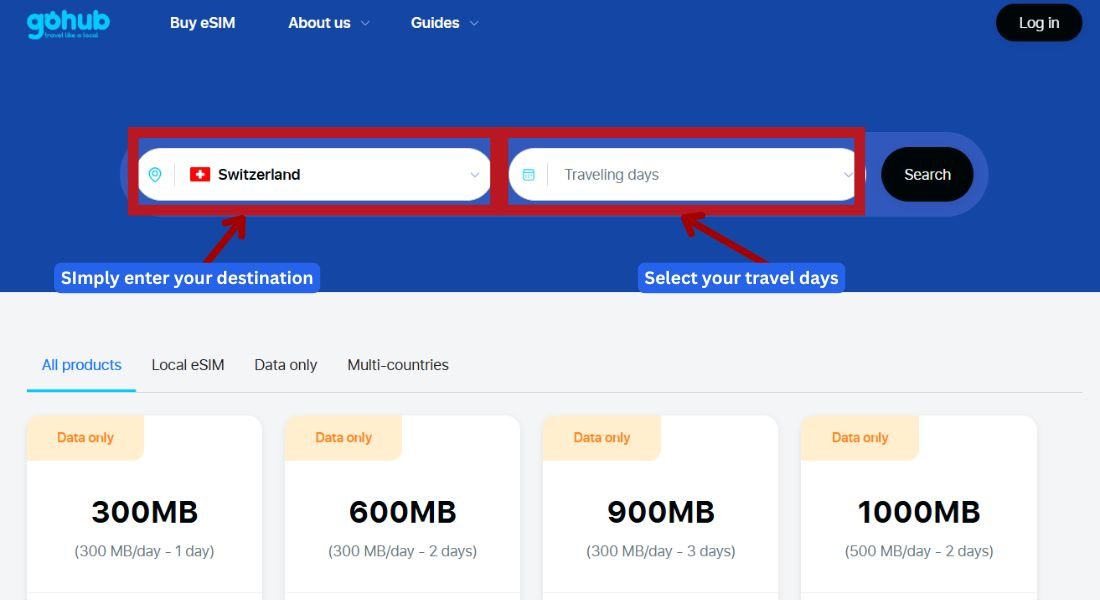
Image: Screenshot of the GoHub eSIM webpage, highlighting the destination input field with “Switzerland” selected, illustrating how users can easily search for eSIM data plans.
Beyond Skiing: Seasonal Activities in Swiss Mountain Resorts
Think Switzerland’s winter is just about skiing?
Think again
Even if you never clip into skis, the Swiss Alps in winter are packed with culture, adventure, and cozy experiences that’ll leave you breathless (and not just from the altitude 😄).
Whether you’re on a rest day, traveling with non-skiers, or just want to explore more — here’s what makes the Alps magical beyond the pistes:
Winter Festivals & Events Worth Timing For
Snow + Champagne + Horse Races on Ice? Yeah… Switzerland goes big.
Plan your trip around these unique seasonal highlights:
| 📅 When | 🎉 What’s Happening |
|---|---|
| January | 🏇 Snow Polo World Cup in St. Moritz – horses galloping on a frozen lake = elite winter energy |
| ⛷️ Lauberhorn World Cup Races in Wengen – legendary downhill madness | |
| February | 🎠 White Turf – horse racing (again!) but now locals dress like it’s fashion week on ice |
| March | 🏔️ Engadinsnow Freeride Comp – big mountain lines + adrenaline highs at Corvatsch |
| All Season | 🎶 Music festivals, torchlight descents, open-air fondue feasts |
Perfect for: Rest days, après-ski evenings, or travel buddies who prefer a raclette party to a red run
📲 Gohub eSIM tip: Use it to check event dates, book last-minute tickets, or grab directions when you’re navigating snowy village streets
Alternative Alpine Adventures: Snow Without Skis
Not into skiing? You’ve got options — and they’re incredible.
- Snowshoeing
- Peaceful trails through forests and snowy meadows
- Rentals + guides available at most resorts
- Winter Hiking
- Cleared & maintained paths — perfect for scenic strolls with mountain views
- Great for multi-generational groups
- Tobogganing (Swiss style)
- Dedicated sled runs (some with night runs lit by lanterns!)
- Try the epic Preda–Bergün run: 6km of pure fun
- Wellness & Thermal Spas
- Soak in outdoor hot pools surrounded by snow
- Favorites: Vals Therme, Leukerbad, and Bogn Engiadina
- Scenic Train Rides
- Glacier Express or Bernina Express = next-level window views
- Ride through frozen valleys, icy viaducts, and snow-kissed peaks
TL;DR?
You don’t have to ski to fall in love with the Swiss Alps in winter. Just bundle up, stay connected, and follow the snowflakes — magic guaranteed 💙
📶 Gohub eSIM = your winter companion
Navigate spa times, trail maps, toboggan rental spots, and book train tickets without a Wi-Fi hunt
Practical Tips for Planning Your Swiss Ski Trip
Switzerland doesn’t play around when it comes to winter — and neither should your packing list or travel plans.
Here’s how to ski smarter, pack wiser, and move like a Swiss train: smooth, scenic, and always on time
Essential Packing for Swiss Winter Conditions
| 🧩 Item | 💡 Why You’ll Thank Yourself |
|---|
| 🧣 Layered Clothing | Weather can swing from “sunbathing at lunch” to “blizzard at 3PM” real fast |
| 🧴 High-SPF Sunscreen + Lip Balm | The alpine sun + snow reflection = ski-goggle tan risk |
| 🎿 Ski Gear (if not renting) | Only pack your own if you’re picky — Swiss rental shops are top-tier |
| 🧤 Waterproof Gloves, Neck Warmer, Hat | Essentials. No further explanation needed |
| 👗 Après Attire | Cozy-chic > red-carpet. Think: smart casual, with snow boots |
| 🔌 Power Adapter | Switzerland = Type J (but C/F often work). Still, bring a universal adapter just in case |
Pro tip: Pack a light down jacket + shell combo for max flexibility on AND off the slopes
Transportation Tips: Getting Around Like a Local
Switzerland’s public transport is legendary — clean, on time, and cuts through mountains like magic.
Swiss Travel Pass
- Unlimited travel on trains, buses, and even boats
- Great value if you plan to visit multiple regions (Zermatt ➝ St. Moritz ➝ Bern? No problem)
- Often includes museums + discounts on mountain excursions
Train Wins All Day
- Most resorts have train stations, or direct bus transfers from nearby towns
- From Airport to Alps:
Zurich ➝ Andermatt, Engelberg, Davos
Geneva ➝ Verbier, Crans-Montana
Hotel Shuttles
- Many accommodations offer free pick-up from the train/bus station
- Check ahead — some need advance booking
Car Rental? Only If You Must
- Great for remote or lesser-known resorts
- Must have: winter tires + snow chains
- Parking is limited in popular ski towns
Gohub eSIM makes all this smoother:
- Book trains + compare transfer options online
- Use SBB (Swiss Rail) app with live updates
- Navigate resort shuttles & find your Airbnb in a snowstorm
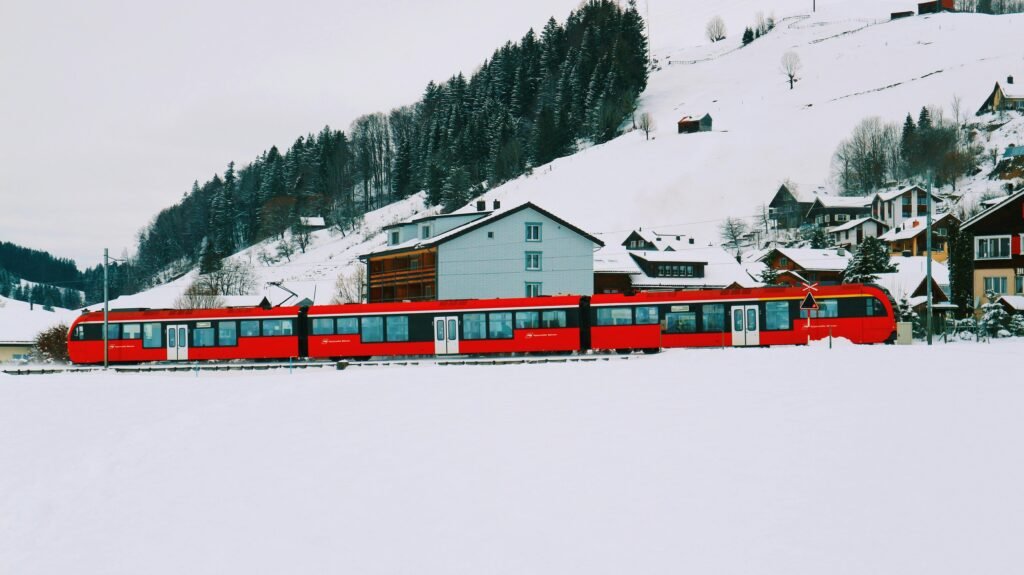
Image: Swiss train traveling through snowy mountain landscape
Month-by-Month Breakdown: When to Book Your Swiss Ski Trip
Let’s break down the entire ski season — month by month, vibe by vibe — so you can book your perfect window of winter magic
November: Early Season Opportunities
Where to Ski: Zermatt, Saas-Fee (glacier zones only)
What to Expect:
- Quiet slopes
- Budget-friendly stays
- Limited terrain open, snow dependent
Go if: You want a warm-up trip or snow fix before peak crowds hit
📱 Gohub it: Check snow cams daily — early season conditions can shift quickly!
December – From Quiet Deals to Holiday Magic
Early December:
- Value-packed! Great snow (if you’re lucky) + very few people
Christmas & New Year:
- Fairy tale vibes
- Crowded slopes
- Peak pricing
Go if: You love twinkly lights, mulled wine, and don’t mind sharing the piste
January – Powder Perfection
- Early Jan: Still festive but crowds ease around Jan 6
- Mid Jan: Coldest = driest snow + less traffic
- Late Jan: Golden sweet spot = Best conditions + best availability
Go if: You want quiet powder days and care more about snow than sun
📶 Gohub Pro Tip: Use it to book avalanche-safe off-piste tours while on the chairlift 😎
February – Peak Season Energy
- Snow: Deep, stable, reliable
- Weather: Cold, but days are getting longer
- Crowds: High – school holidays = packed lifts + pricey passes
Go if: You’re booking in advance, traveling with family, or don’t mind crowds for perfect snow
Avoid if: You hate lines and want peace
March – Springy Vibes + Deep Snow
- Snow base = THICK
- Days = longer, sunnier
- Perfect for: Long ski days, lunches on panoramic terraces
Note: If Easter falls in March, expect a small crowd spike
Go if: You want a balance of snow + sun + space
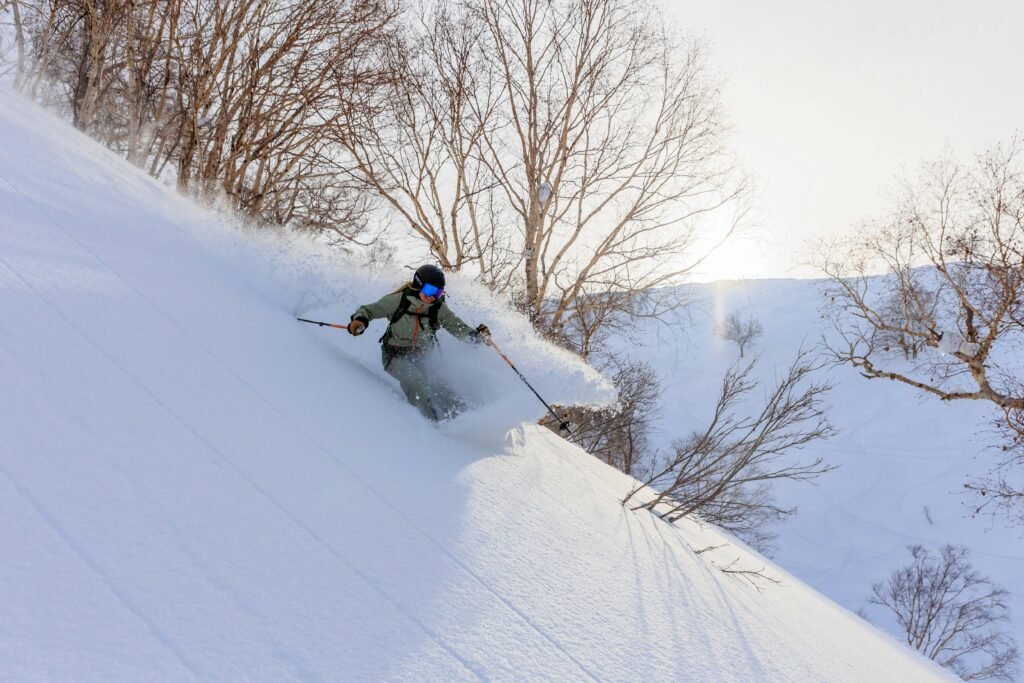
Image: Sunny spring skiing in March with mountain views
April – Final Turns & Fondue
- Still skiable at high resorts (Zermatt, Verbier, Saas-Fee)
- Conditions shift fast: powder in the morning, slush by 2PM
- End-of-season deals = 😍
Go if: You’re chill with softer snow, blue skies, and empty lifts
Avoid lower resorts unless it’s just for the view
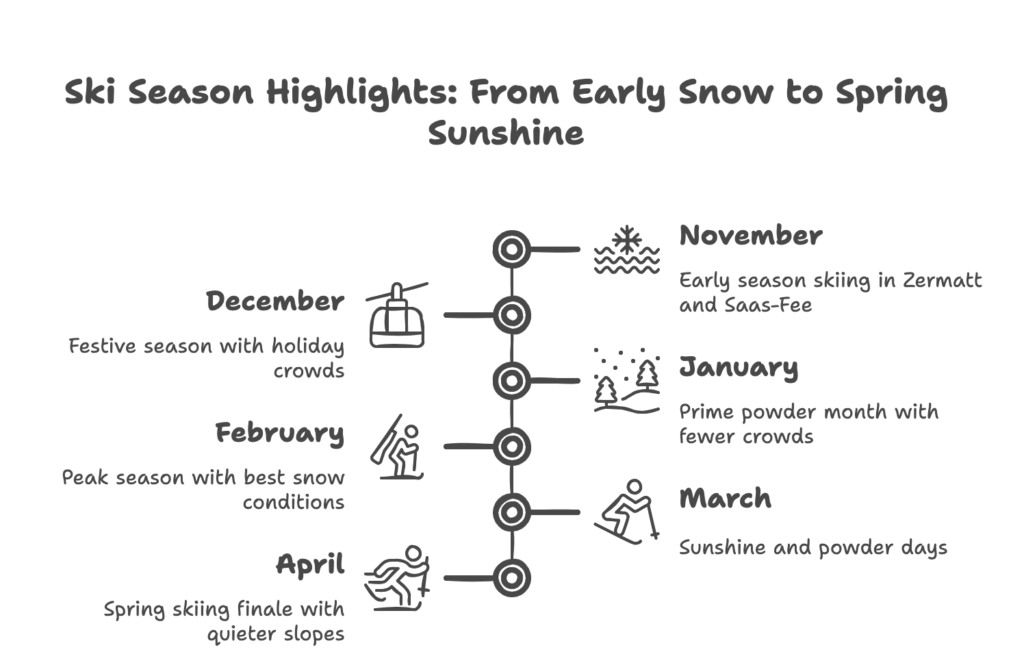
Expert Picks: Best Time to Ski Switzerland (Based on You)
No two skiers are the same — so why should your timing be?
Here’s your personalized cheat sheet to find the perfect Swiss ski window, based on your vibe, budget, and crew:
Best Time for Families with Children
Families should consider these factors:
- School holiday considerations: Book well in advance if restricted to these periods
- Recommended timing: January after Epiphany (January 6th) or March before Easter
- Resort suggestions: Wengen, Grindelwald, or Arosa offer excellent family facilities
- Weather factors: Mid-season offers reliable conditions without extreme cold
Ideal Periods for Powder Seekers and Freeriders
Off-piste enthusiasts should target:
- Prime powder months: Mid-January through February
- Resort recommendations: Engelberg, Andermatt, Verbier for the best freeride terrain
- Timing strategy: Be ready for midweek trips when storms are forecast
- Safety reminder: Always ski with proper avalanche safety equipment and knowledge
Optimal Timing for Budget-Conscious Skiers
Save money by targeting these periods:
- Value seasons: Early December, mid-January, late March/April
- Weekday advantage: Sunday to Friday stays often cost less
- Package deals: Look for ski-inclusive packages during off-peak weeks
- Resort selection: Consider less famous destinations like Arosa, Laax, or Andermatt
Conclusion: Finding Your Perfect Swiss Ski Window
The best time to ski in Switzerland ultimately depends on your personal priorities. If perfect powder and minimal crowds are your focus, aim for mid-January through early February. Families restricted to school holidays should book well in advance for February or Easter breaks. Budget-conscious travelers will find the best values in early December, mid-January, or late March.
Regardless of when you visit, Switzerland offers some of the world’s most spectacular skiing across its diverse resorts. From the iconic Matterhorn views in Zermatt to the extensive terrain of the 4 Vallées around Verbier, Swiss ski areas deliver world-class experiences throughout the winter season.
Before embarking on your Swiss alpine adventure, don’t forget to secure your Gohub eSIM for seamless connectivity throughout your journey. With reliable internet access, you’ll navigate Switzerland’s mountains with confidence, check weather and avalanche conditions, and share your spectacular skiing moments with friends and family back home.
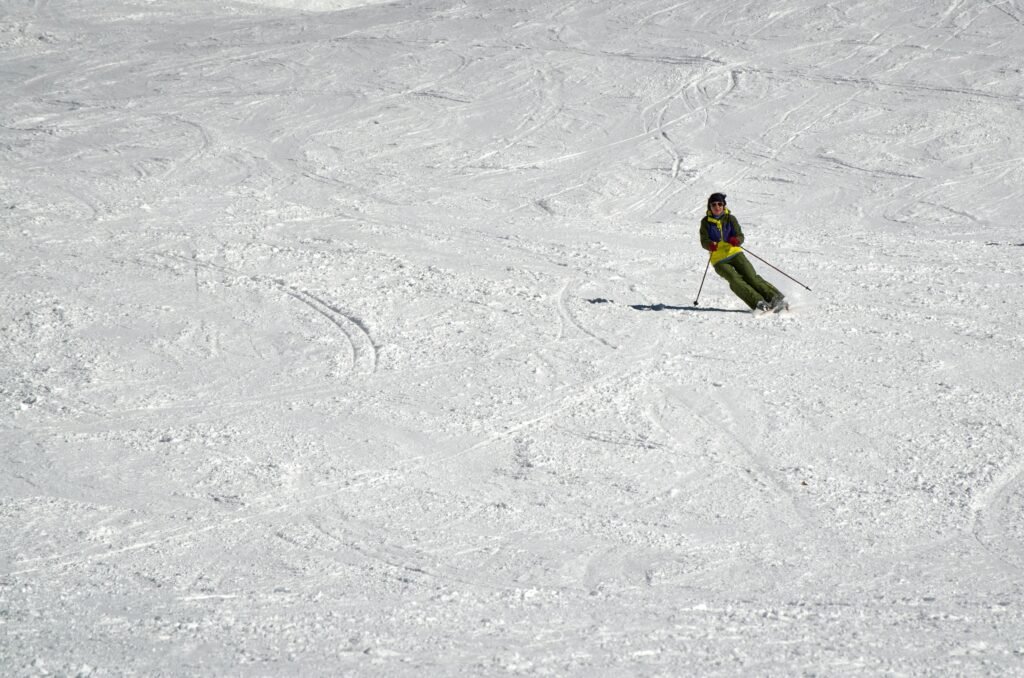
Image: Group of happy skiers enjoying après-ski on a mountain terrace
📶 Stay connected from the Alps to après-ski cafés — Gohub’s eSIM keeps your phone online across Europe with no roaming charges and instant setup.
Ready to experience the magic of Swiss skiing? Get your Gohub eSIM prior to your journey and take advantage of uninterrupted connectivity as soon as you get there. Stay connected, navigate the mountains with confidence, and share your Swiss Alps adventures with friends and family back home!







